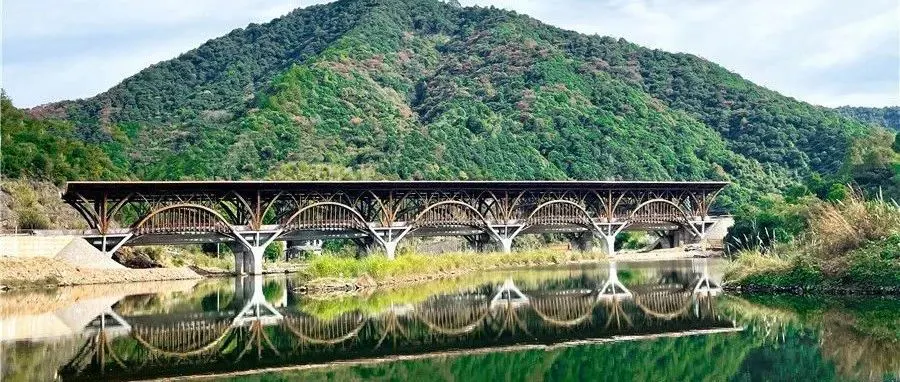Why did a Chinese bamboo bridge win an international award?

Bamboo is a symbol of resilience, humility, and wisdom in Eastern culture, and is honored as one of the "Four Gentlemen," representing noble qualities and unyielding spirit.
CNS reporter Long Min

The annual International Bridge Conference (IBC) recently announced the results of its awards evaluation. The "Linglong" bamboo bridge, located at the west gate of the Wuyi Mountain National Park in Fujian Province, China, won the Arthur G. Hayden Medal, which recognizes outstanding achievements in the innovation of special-purpose bridges.
The full view of the "Linglong" Bridge at the West Gate of Wuyi Mountain National Park. Photo courtesy of the interviewee.
How does a Chinese bamboo bridge attract the attention of people from both China and abroad? Shao Changzhuan, a council member of the China Bamboo Industry Association and the designer of the "Linglong" bamboo bridge, recently answered this question in an interview with China News Service's "East and West" column.
The following is a summary of the interview transcript:
Reporter from China News Service: Why was a bamboo bridge built in the Wuyi Mountain National Park?
Shao Changzhuan: Wuyi Mountain National Park is one of the first officially established national parks in China. It is also the only national park in China that is both a UNESCO Biosphere Reserve and a dual World Cultural and Natural Heritage site. It spans Fujian and Jiangxi provinces, covering a total area of square kilometers.
As the west gate of Wuyi Mountain National Park, the mission of this bridge is not only for transportation but also for showcasing the image and cultural characteristics of the national park.
"Linglong" Bridge interior. Photo provided by interviewee.
Bamboo bridges are undoubtedly the optimal choice. In recent years, with the continuous emergence of environmental issues and the rise of sustainable development concepts around the world, the demand for environmental protection and sustainable construction has become increasingly urgent. In this context, bamboo, with its excellent ecological performance, can serve as a substitute for many materials while having high economic value, making it a sustainable organic construction material for the future.
Therefore, this bamboo bridge employs traditional processing and manufacturing techniques, using round bamboo as the main construction material, sourced locally. This not only reduces construction costs but also promotes the development of the local bamboo industry, showcasing the ecological characteristics of the Wuyi Mountain National Park.
The bamboo bridge gracefully spans the water, tightly connecting the landscape with the countryside, becoming an indispensable lively link in the theme of "Landscape Bamboo Charm." A bamboo bridge placed within a landscape painting creates a unique experience of "crossing the bridge into the painting scroll."
Reporter from China News Service: How was the bamboo bridge located at the western gate of Wuyi Mountain National Park in Fujian Province designed and constructed?
Shao Changzhuan: Bamboo, as the main material, has the advantages of good toughness and fast growth, but its disadvantages are also obvious, such as easy cracking and poor durability. Therefore, during the design and construction process, the "Linglong" bamboo bridge also encountered many difficulties.
In the process of handling bamboo, the first step is to open the nodes to equalize the internal and external pressure, effectively preventing the bamboo from cracking; subsequently, multiple processing steps are required to meet the usage requirements of the bamboo.
Compared to reinforced concrete or steel, which have only two elastic parameters, bamboo, due to its different growth directions, circumferential, and radial orientations—referred to as anisotropy in technical terms, has multiple parameters, significantly increasing the complexity of its stress research.
The team once faced difficulties such as the absence of regulations and the lack of specialized auxiliary calculation software. They had to rely on experiments and coordinate multiple structural calculation software to complete the design. Using local bamboo as the main material, the "Linglong" bamboo bridge enhanced the building performance of the bamboo through treatment. Two bamboo arch pedestrian bridges, each . meters wide, were constructed on both sides of the original vehicular bridge. A roof on the arches connected the two bamboo bridges into an integrated covered bridge. The bamboo arch bridge spans meters in length, making it the longest of its kind in China.
Linglong Bridge Corridor Roof. Photo courtesy of the interviewee.
Bamboo bridges are equipped with steel corbels at the top of piers as the link connecting various bamboo arch structures, forming multi-span round bamboo-steel hybrid arch bridges to enhance the bridge's span capacity. The cross-section of the bamboo arch adopts a multi-bundle round bamboo large-section form, with bamboo as the main material and steel as the auxiliary, fully leveraging the advantages of both materials. This ensures the bamboo arch structure has sufficient load-bearing capacity while increasing its aesthetic appeal.
The curved line shape of bamboo arches also has a distinct guiding and indicative effect, guiding the gaze of visitors and creating a soft and pleasant visual experience, allowing people to feel freedom and romance.
Reporter from China News Service: Compared to other bridges such as bamboo bridges, stone bridges, and wooden arch bridges, what are the similarities and differences? What architectural styles and cultural symbols do they embody?
Shao Changzhuan: Bamboo bridges are a common form of bridge in some regions, especially in Southeast Asia and southern China. Compared to other types of bridges such as stone bridges and wooden arch bridges, bamboo bridges place greater emphasis on the harmony between nature and ecology in material selection. Bamboo, as a rapidly growing and renewable resource, not only has good flexibility and load-bearing capacity but also possesses strong tensile properties.
The design of bamboo bridges often seeks harmony and unity with the surrounding environment, emphasizing the smoothness of lines and the lightness of structure. Unlike the heaviness of stone bridges and the grandeur of wooden bridges, bamboo bridges focus on achieving maximum functional effects with minimal materials. Employing traditional manual techniques, they skillfully combine individual bamboo stalks through weaving and binding, embodying the Eastern aesthetic of simplicity, allowing people to more easily find the authentic charm, and achieving an expression that touches both the scene and the heart.
Detail image of Linglong Bridge. Photo courtesy of interviewee.
Bamboo, symbolizing resilience, humility, and wisdom in Eastern culture, is honored as one of the "Four Gentlemen," representing noble qualities and unyielding spirit. Thus, a bamboo bridge is not merely a means of transportation, carrying the mission of bridging rivers, but also embodies people's pursuit and longing for virtuous character.
The bamboo bridge is also integrated with local folk activities, becoming a special symbol in important occasions such as festivals and sacrificial ceremonies, carrying rich cultural connotations and historical memories. It not only meets people's functional needs but also closely connects with their lives on a spiritual level, becoming a poetic and philosophical architectural form.
Reporter from China News Service: What makes the "Linglong" bamboo bridge attract global attention and win the Arthur Heyden Award?
Shao Changzhuan: The Arthur G. Hayden Medal is one of the seven major awards of the International Bridge Conference, which aims to recognize outstanding projects that have achieved innovative breakthroughs in the fields of pedestrian bridges, people mover systems, and non-traditional structures. The International Bridge Conference, hosted by the Engineers' Society of Western Pennsylvania, is an international academic conference on bridges. Since the establishment of the awards, it has been renowned for its authority, professionalism, and internationality, often referred to as the "Nobel Prize" of the bridge world.
The "Linglong" bamboo bridge, in addition to its own design and construction, has also become a distinctive "green bridge" and "ecological bamboo bridge" in the Wuyi Mountain National Park scenic area due to its low-carbon and environmentally friendly concept.
A panoramic view of the "Exquisite" bamboo bridge. Photo provided by the interviewee.
The construction of the bamboo bridge utilized 100,000 round bamboo culms, which can sequester approximately 1,000 tons of carbon and consume about 1,000 tons of carbon dioxide. Therefore, this bamboo bridge, along with the magnificent and breathtaking natural scenery around Wuyi Mountain, has attracted the attention of the international bridge community.
At the International Bridge Conference, the "Linglong" bamboo bridge won the Arthur G. Hayden Medal for its design concept and construction technology.
Reporter from China News Service: What ideas does the construction of the bamboo bridge provide for the green development of future architecture?
Shao Changzhuan: The completion of this bamboo bridge not only showcases the potential of bamboo in the field of structural engineering but also opens up new paths and possibilities for the green development trend in the construction industry.
Bamboo, as a plant with rapid growth and a short regeneration cycle, has minimal environmental impact and is a significant component of the "green mine"—the "bamboo mine." The "green mine" primarily refers to surface resources, including ecosystems such as forests, grasslands, wetlands, lakes, and oceans, which are renewable resources that can be cyclically utilized. The "bamboo mine" is a type of naturally grown or artificially cultivated bamboo, belonging to the "green mine" and representing a notable category within it.
In the past two centuries, human society has experienced industrial revolutions and unprecedented technological advancements, largely driven by resources such as coal, oil, and iron ore, often referred to as "black mines." However, throughout the long course of human development, "green mines" have been the resources that have accompanied human evolution for the longest time. The construction of bamboo bridges demonstrates how the ecological material known as "bamboo mine" can be integrated with modern engineering techniques, offering valuable lessons for other construction projects. In the future, more "bamboo mines" will be widely applied in bridges, houses, and other infrastructure.
"Bamboo Living City" refers to a city development model that primarily uses bamboo as its main material, integrating ecology, culture, industry, and harmonious urban space. It signifies the comprehensive integration of bamboo into people's lives and environments, becoming an essential element in the construction of urban areas, scenic spots, rural areas, and cultural projects. While bridges are just a part of urban construction, the completion of a bamboo bridge represents another practice of our "Bamboo Living City" concept.
In the future, bamboo will be widely integrated and applied in various fields such as urban architecture, city landscapes, public facilities, venue construction, road and bridge infrastructure, and urban furniture. This will not only broaden and extend the industrial chain but also bring more possibilities to cities, enhancing urban image, promoting industrial development, improving living environments, and achieving urban revitalization.
Interviewee Profile:*
Shao Changzhuan. Photo courtesy of the interviewee. Shao Changzhuan is a joint-trained PhD from the Department of Architecture at the Chinese University of Hong Kong and the Department of Civil Engineering at Tsinghua University. He is a council member of the China Bamboo Industry Association, primarily engaged in research and practice on medium to large-span bamboo cultural architecture and bamboo cultural living environments. He has led the design and construction of the world's largest bamboo building, the Yibin International Bamboo Industry Trade Center, and the world's longest bamboo bridge, the Bamboo Bridge in the West District of the Wuyi Mountain National Park West Gate.
Title: "Shao Changzhuan: Why Did a Bamboo Bridge in China Win an Award at the International Bridge Conference? East and West" Text Editor: Pei Xinyu Photo Editor: Cui Chuqiao Layout: Ding Baoxiu Review: Wei Yuan Editor: Song Fangcan
[
How much do we know about wedding attire from all corners of the world throughout history?
](http://mp.weixin.qq.com/s?__biz=MjM5NDI2MDc5NA==&mid=2659526574&idx=2&sn=28e853319fb970c61ece44bc01a1c4ea&chksm=bdfbf5fb8a8c7cedf49cf3f6a727d774c85f509c74362e413050df05bc0d353d822a36b6437e&scene=21#wechat_redirect)
[
How did the Yangtze River civilization rise?
](http://mp.weixin.qq.com/s?__biz=MjM5NDI2MDc5NA==&mid=2659526356&idx=1&sn=8683b018226afc3f2cc2714b87b78a24&chksm=bdfbf4818a8c7d97264abf5223aa54655e035410112e630362b28600edca935ea2ec2786cc26&scene=21#wechat_redirect)
[
The millennium-old Tang-Tibet Ancient Road, why does it remain fresh and enduring?
](http://mp.weixin.qq.com/s?__biz=MjM5NDI2MDc5NA==&mid=2659526356&idx=2&sn=355542edcd6be1076b76193f695d675b&chksm=bdfbf4818a8c7d97f3b38ec4f8864a08bb32dab6af5322e387e0dfb8cf61459b5bae7c0eb570&scene=21#wechat_redirect)
